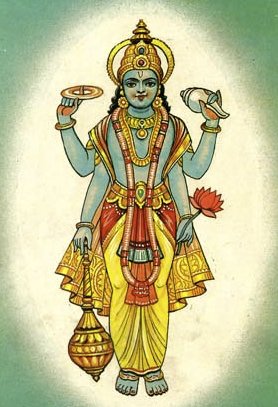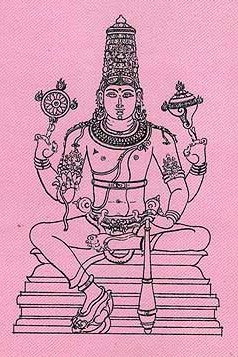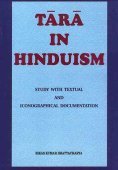Pancaratra, Pamcaratra, Panca-ratra, Pancan-ratra, Pañcarātra, Pāñcarātra: 18 definitions
Introduction:
Pancaratra means something in Hinduism, Sanskrit. If you want to know the exact meaning, history, etymology or English translation of this term then check out the descriptions on this page. Add your comment or reference to a book if you want to contribute to this summary article.
Alternative spellings of this word include Pancharatra.
In Hinduism
Vaishnavism (Vaishava dharma)
Source: ISKCON Press: GlossaryPañcarātra (पञ्चरात्र).—Vedic literatures describing the process of Deity worship.
Source: Pure Bhakti: Bhagavad-gita (4th edition)Pañcarātra (पञ्चरात्र) refers to “group of devotional scriptures that assist in the practice of the principal limbs of bhakti; they cover five topics: (a) the process of cleansing the temple, (b) performing āratika with flowers, incense, etc., (c) worship, bathing, etc. of the deity of Śrī Viṣṇu, (d) the performance of meditation on the holy name and on śrī gāyatrī, (e) recita-tion of verses and prayers, performance of nāma-kīrtana and study of scriptures such as Bhagavad-gītā and Śrīmad-Bhāgavatam, which establish tattva-jñāna. The Pañcarātras are numerous, some of them being prominent in the Gauḍīya Vaiṣṇava lineage: Śrī Nārada-pañcarātra, Śrī Hayaśīrṣa-pañcarātra and Śrī Śāṇḍilya-pañcarātra”. (cf. Glossary page from Śrīmad-Bhagavad-Gītā).
Source: Pure Bhakti: Arcana-dipika - 3rd EditionPañcarātra (पञ्चरात्र) refers to:—A section of the Vedic scriptures. There are many Pañcarātras. Those mostly referred to by the Gauḍīya sampradayā are Śrī Nārada-pañcarātra, Śrī Hayaśīrṣa-pañcarātra and Śrī Śāṇḍilya-pañcarātra. (cf. Glossary page from Arcana-dīpikā).
Source: Pure Bhakti: Brhad BhagavatamrtamPañcarātra (पञ्चरात्र) refers to:—System of Deity worship initiated by Śrī Nārada; a group of scriptures that support the process of bhakti. (cf. Glossary page from Śrī Bṛhad-bhāgavatāmṛta).

Vaishnava (वैष्णव, vaiṣṇava) or vaishnavism (vaiṣṇavism) represents a tradition of Hinduism worshipping Vishnu as the supreme Lord. Similar to the Shaktism and Shaivism traditions, Vaishnavism also developed as an individual movement, famous for its exposition of the dashavatara (‘ten avatars of Vishnu’).
Purana and Itihasa (epic history)
Source: archive.org: Puranic Encyclopedia1) Pañcarātra (पञ्चरात्र).—An āgama (a system of philosophy). (Chapter 218, Śānti Parva).
2) Pāñcarātra (पाञ्चरात्र).—A book of spiritual doctrines. He who learns this will attain the position of Uparicaravasu. Śloka 25, Chapter 325, Śānti Parva).
Source: archive.org: Nilamata Purana: a cultural and literary studyPāñcarātra (पाञ्चरात्र) refers to a system of worship that was once commonly practised in ancient Kashmir (Kaśmīra) according to the Nīlamatapurāṇa.—Pāñcarātra system of worship is prescribed for the worship of Viṣṇu, which in its turn anticipates the popularity of the Pāñcarātra cult in Kaśmīra. The cults of the Bhāgavatas and the Pāñcarātras were originally different; the former had Vāsudeva-Nārāyaṇa as their deity and the latter worshipped four Vyūhas, namely, Vāsudeva, Saṅkarṣaṇa, Aniruddha and Pradyumna.

The Purana (पुराण, purāṇas) refers to Sanskrit literature preserving ancient India’s vast cultural history, including historical legends, religious ceremonies, various arts and sciences. The eighteen mahapuranas total over 400,000 shlokas (metrical couplets) and date to at least several centuries BCE.
Pancaratra (worship of Nārāyaṇa)
Source: Shodhganga: Iconographical representations of Śiva (pancaratra)Pāñcarātra (पाञ्चरात्र) or Pāñcarātrāgama refers to one of the two classifications of Vaiṣṇavāgamas: one of the three classes of āgamas (traditionally communicated wisdom).—Texts of the Pāñcara Āgamas are divided in to two sects. It is believed that Lord Vāsudeva revealed the first group of texts which are called Divya and the next group is called Muniprokta which are further divided in to three viz. a. Sāttvika. b. Rājasa. c. Tāmasa.
Source: Shodhganga: Kasyapa Samhita—Text on Visha Chikitsa (p)Pāñcarātra (पाञ्चरात्र) refers to one of the two divisions of the Vaiṣṇava Āgamas (the other being Pāñcarātra).—Pāñcarātra is so called because it comprises the five discourses delivered by Lord Nārāyaṇa to the five deities, Brahmā, Indra, Rudra and other Devas respectively. Some opine that it is so called because, the other five schools of philosophy, Sāṅkhya, Yoga and others were obscured by it. (‘rātri’ meaning diminish or obscure) says the Aniruddha Saṃhitā (I. 34cd-35).
The term ‘pāñcarātra’ could also allude to the five modes of knowledge according to the Pauṣkara Saṃhitā. (38.307). The word ‘rātra’ denoting knowledge, refers to the five kinds of knowledge (Nāradapāñcarātra, 9.9). The five saṃskāras are tapa, puṇḍra, nāma, mantra and yoga says Viṣṇutilaka Saṃhitā (IV.189. 90b). The word ‘pāñcarātra’ could also point to the important vyūha doctrine i.e. the five forms of Nārāyaṇa as Para, Vyūha, Vibhava, Antaryāmin and Arcā. The Viṣṇutantra (I. 74-6) maintains that the term ‘pāñcarātra’ refers to the five elements–earth, air, fire, air and ether, as fetters which bind the souls to this world and Pāñcarātra is the science which eschews the ignorance brought about by these elements.

Pancaratra (पाञ्चरात्र, pāñcarātra) represents a tradition of Hinduism where Narayana is revered and worshipped. Closeley related to Vaishnavism, the Pancaratra literature includes various Agamas and tantras incorporating many Vaishnava philosophies.
Shaktism (Shakta philosophy)
Source: Google Books: ManthanabhairavatantramPañcarātra (पञ्चरात्र) refers to “five nights”, according to the second recension of the Yogakhaṇḍa of the Manthānabhairavatantra, a vast sprawling work that belongs to a corpus of Tantric texts concerned with the worship of the goddess Kubjikā.—Accordingly, “In the meantime, once the goddess had crossed over the most excellent Yoga and once the fifth night [i.e., pañcarātra—vyatīte pañcame rātre] had passed, she emerged from the middle of the Liṅga. (This took place) in an auspicious (śiva) month on the auspicious (śiva) eighth (day of the lunar month) at the end of the middle of the night. She has the form of a sixteen (year-old girl), is dark blue and red and has three eyes. She laughs subtly and is adorned with six faces. She has twelve arms, a crooked form and faces downwards”.

Shakta (शाक्त, śākta) or Shaktism (śāktism) represents a tradition of Hinduism where the Goddess (Devi) is revered and worshipped. Shakta literature includes a range of scriptures, including various Agamas and Tantras, although its roots may be traced back to the Vedas.
Yoga (school of philosophy)
Source: ORA: Amanaska (king of all yogas): A Critical Edition and Annotated Translation by Jason BirchPañcarātra (पञ्चरात्र) refers to the “time of five nights ”, according to the Amanaska Yoga treatise dealing with meditation, absorption, yogic powers and liberation.—Accordingly, as Īśvara says to Vāmadeva: “[...] [Now], I shall define the nature of that highest, mind-free absorption which arises for those devoted to constant practice. [...] By means of an absorption for five [days and] nights (pañcarātra), the faculty of hearing from afar, which causes great wonder, certainly arises for the [Yogin]. [...]”.

Yoga is originally considered a branch of Hindu philosophy (astika), but both ancient and modern Yoga combine the physical, mental and spiritual. Yoga teaches various physical techniques also known as āsanas (postures), used for various purposes (eg., meditation, contemplation, relaxation).
Nirukta (Sanskrit etymology)
Source: Shodhganga: Kasyapa Samhita—Text on Visha Chikitsa (nirukta)Pañcarātra (पञ्चरात्र) as explained by the Viśvāmitra Saṃhitā (2. 3-5).—The term ‘pañca’ refers to the group of five sense organs, five elements and their qualities. The term ‘rā’ means ignorance; ‘tra’ means ‘trāṇa’ and refers to protection. Hence ‘pañcarātra’ refers to protection of the individual soul from the group of five.
Nirukta (निरुक्त) or “etymology” refers to the linguistic analysis of the Sanskrit language. This branch studies the interpretation of common and ancient words and explains them in their proper context. Nirukta is one of the six additional sciences (vedanga) to be studied along with the Vedas.
Languages of India and abroad
Sanskrit dictionary
Source: DDSA: The practical Sanskrit-English dictionaryPāñcarātra (पाञ्चरात्र).—Name of a Vaiṣṇava sect and its doctrine; भक्तिमार्ग (bhaktimārga); परस्पराङ्गान्येतानि पाञ्चरात्रं च कथ्यते । एष एकान्तिनां धर्मो नारायणपरात्मकः (parasparāṅgānyetāni pāñcarātraṃ ca kathyate | eṣa ekāntināṃ dharmo nārāyaṇaparātmakaḥ) || Mahābhārata (Bombay) 12.348.82.
Derivable forms: pāñcarātram (पाञ्चरात्रम्).
--- OR ---
Pañcarātra (पञ्चरात्र).—
1) a period of five nights; इत्यर्थं वयमानीताः पञ्चरात्रोऽपि विद्यते (ityarthaṃ vayamānītāḥ pañcarātro'pi vidyate) Pañch.3.24.
2) Name of one of Bhāsa's dramas.
3) Name of a philosophical treatise attributed to Nārada.
4) Name of an अहीन (ahīna) (sacrifice) lasting for 5 days; स एतं पञ्चरात्रं पुरुषमेधं यज्ञक्रतुमपश्यत् (sa etaṃ pañcarātraṃ puruṣamedhaṃ yajñakratumapaśyat) Śat. Br.; cf. Mahābhārata (Bombay) 12.218. 11.
Derivable forms: pañcarātram (पञ्चरात्रम्).
Pañcarātra is a Sanskrit compound consisting of the terms pañcan and rātra (रात्र).
Source: Cologne Digital Sanskrit Dictionaries: Cappeller Sanskrit-English DictionaryPañcarātra (पञ्चरात्र).—1. [masculine] five days (nights).
--- OR ---
Pañcarātra (पञ्चरात्र).—2. [adjective] lasting five days.
Source: Cologne Digital Sanskrit Dictionaries: Aufrecht Catalogus Catalogorum1) Pañcarātra (पञ्चरात्र) as mentioned in Aufrecht’s Catalogus Catalogorum:—See Kapilapañcarātra, Nāradapañcarātra, Hayagrivapañcarātra, and Pāñcarātra. Quoted by Hemādri, in Sarvadarśanasaṃgraha Oxf. 247^a, by Devanātha L. 2010, in Dānamayūkha, Smṛtyarthasāgara, etc.
2) Pāñcarātra (पाञ्चरात्र):—Oppert. Ii, 1915. 4721. 5224. 8500. Rice. 96. See Pañcarātra. Pāñcarātre Agastyasaṃhitā. Mysore. 3.
—Aṅkurārpaṇavidhi. Taylor. 1, 135.
—Aniruddhasaṃhitā. Mysore. 3.
—Anekotsavapratipādakasaṃhitāsārasaṃgraha. Mysore. 3.
—Ahirbudhnyasaṃhitā. Mysore. 3.
—Kārtavīryamāhātmya. Oppert. Ii, 6631.
—Jitaṃtestotra. Burnell. 201^a. Bhr. 551.
—Jñānapādavyākhyāna. Mysore. 3.
—Nāradīyasaṃhitā. Mysore. 3.
—Pādmasaṃhitā. Mysore. 3.
—Pārameśvarasaṃhitā. Mysore. 3.
—Pauṣkarasaṃhitā. Mysore. 3.
—Prayogamaṇimālikā. Mysore. 3. Taylor. 1. 425.
—Prāyaścittasaṃgraha. Mysore. 3.
—Bharadvājasaṃhitā. Mysore. 3.
—Maṇḍalārcana. Oppert. Ii, 4106.
—Mahāgastyasaṃhitā. Oppert. Ii, 4107.
—Mahotpātaprāyaścitta. Oppert. Ii, 4108.
—Mahotsavavidhi. Oppert. Ii, 4109.
—Mārkaṇḍeyasaṃhitā. Mysore. 3.
—Veṅkaṭeśamāhātmya. Rice. 90.
—Vaikhānasabhṛgusaṃhitā. Mysore. 3.
—Śeṣasaṃhitā. Mysore. 3.
—Samprokṣaṇādividhayaḥ. Mysore. 3.
—Sātvatasaṃhitā. Mysore. 2.
Pāñcarātra has the following synonyms: Pāñcarātrāgama.
3) Pāñcarātra (पाञ्चरात्र):—on architecture. Quoted by Rāmrāj.
—[commentary] by Peḍḍanācārya. [Mackenzie Collection] 132.
4) Pañcarātra (पञ्चरात्र):—See Aurvaº, Kāśyapaº, Kratuº Mahāpañcarātra.
5) Pāñcarātra (पाञ्चरात्र):—Quoted by Utpala in Spandapradīpikā. Pāñcarātre Kārttikamāhātmya. Hz. 1535.
—Dhanurmāsamāhātmya. Ak 143.
1) Pañcarātra (पञ्चरात्र):—[=pañca-rātra] [from pañca] m. a period of 5 days (nights), [Kauśika-sūtra; Manu-smṛti] etc.
2) [v.s. ...] mfn. (tra) lasting 5 days, [Śatapatha-brāhmaṇa; Mahābhārata] (also traka, [Pañcatantra])
3) [v.s. ...] m. Name of an Ahīna (See 1. ah) which lasts 5 days, [Tāṇḍya-brāhmaṇa; ???]
4) [v.s. ...] Name of the sacred books of various Vaiṣṇava sects (also [plural]), [Mahābhārata; Rāmāyaṇa etc.]
5) Pāñcarātra (पाञ्चरात्र):—[=pāñca-rātra] [from pāñca] m. [plural] Name of a Vaiṣṇava sect following the doctrine of their sacred book called Pañcarātra, [Sarvadarśana-saṃgraha; Colebrooke; Catalogue(s)]
6) [v.s. ...] n. the doctrine of the Pāñcarātras, [ib.] (also trya and traka)
7) [v.s. ...] Name of sub voce works.
[Sanskrit to German]
Sanskrit, also spelled संस्कृतम् (saṃskṛtam), is an ancient language of India commonly seen as the grandmother of the Indo-European language family (even English!). Closely allied with Prakrit and Pali, Sanskrit is more exhaustive in both grammar and terms and has the most extensive collection of literature in the world, greatly surpassing its sister-languages Greek and Latin.
Kannada-English dictionary
Source: Alar: Kannada-English corpusPāṃcarātra (ಪಾಂಚರಾತ್ರ):—[noun] a Vaiṣṇava religious system that combines five different doctrines, holding Vāsudēva-Křṣṇa as the supreme and other main forms Saṃkarṣana, Pradyumna, Aniruddha are emanated of Vāsudēva, and this system in the beginning was different from the vedic forms of worship.
Kannada is a Dravidian language (as opposed to the Indo-European language family) mainly spoken in the southwestern region of India.
See also (Relevant definitions)
Partial matches: Ratra, Panca.
Starts with (+4): Pancaratradipika, Pancaratragama, Pancaratraka, Pancaratrakadipika, Pancaratrakanaivedyavidhana, Pancaratrakapakvannavidhana, Pancaratrakaprayashcitta, Pancaratrakaraksha, Pancaratramahopanishad, Pancaratramantra, Pancaratramantram, Pancaratranaivedyavidhana, Pancaratrapakvannavidhana, Pancaratraprayashcitta, Pancaratraprayashcittavidhana, Pancaratraradhana, Pancaratrarahasya, Pancaratraraksha, Pancaratrarasthapana, Pancaratrasamgraha.
Ends with: Atikalapancaratra, Aurvapancaratra, Devapancaratra, Hayagrivapancaratra, Hayashirshapancaratra, Kapilapancaratra, Kashyapapancaratra, Kratupancaratra, Mahakapilapancaratra, Mahapancaratra, Naradapancaratra, Nardapancaratra, Shripancaratra.
Full-text (+3753): Pancaratraraksha, Pancaratrika, Ratraka, Pancaratravacana, Pancaratrasthapana, Pancaratraprayashcittavidhana, Pancaratrarahasya, Pancaratrasamgraha, Pancaratramantra, Pancaratramahopanishad, Pancaratrashricurnaparipalana, Pancaratraprayashcitta, Pancaratradipika, Pancaratranaivedyavidhana, Pancaratrapakvannavidhana, Pancaratragama, Pancaratraradhana, Naradapancaratra, Vavara, Yajnaguhya.
Relevant text
Search found 63 books and stories containing Pancaratra, Pamcaratra, Pāṃcarātra, Panca-ratra, Pañca-rātra, Pāñca-rātra, Pānca-rātra, Pancan-ratra, Pañcan-rātra, Pañcarātra, Pāñcarātra, Pāncarātra; (plurals include: Pancaratras, Pamcaratras, Pāṃcarātras, ratras, rātras, Pañcarātras, Pāñcarātras, Pāncarātras). You can also click to the full overview containing English textual excerpts. Below are direct links for the most relevant articles:
Expiatory Rites in Keralite Tantra (by T. S. Syamkumar)
2. Expiatory Rites in Vaiṣṇava Tantras < [Chapter 2 - Expiatory Rites in Āgamic Literature]
1.4. Expiatory Rites In Mataṅgaparameśvara-āgama < [Chapter 2 - Expiatory Rites in Āgamic Literature]
5.2. Causes of Impurity in Dharmaśāstras < [Chapter 4 - Socio-Cultural aspects of Expiatory Rites]
The Bhagavata Purana (by G. V. Tagare)
Part 3 - The Bhāgavata Purāṇa and Pāñcarātra < [Introduction]
Notes regarding the Vyūhas (manifestations of God) < [Appendices]
Part 4 - The Teaching of the Bhāgavata Purāṇa < [Introduction]
A History of Indian Philosophy Volume 2 (by Surendranath Dasgupta)
Part 12 - Bhāgavata and the Bhagavad-gita < [Chapter XIV - The Philosophy of the Bhagavad-gītā]
Part 12 - Viṣṇu, Vasudeva and Kṛṣṇa < [Chapter XIV - The Philosophy of the Bhagavad-gītā]
Part 3 - Sāṃkhya and Yoga in the Gītā < [Chapter XIV - The Philosophy of the Bhagavad-gītā]
Brahma Sutras (Nimbarka commentary) (by Roma Bose)
Brahma-Sūtra 2.2.42 < [Adhikaraṇa 8 - Sūtras 42-45]
Brahma-Sūtra 2.2.45 < [Adhikaraṇa 8 - Sūtras 42-45]
Brahma-Sūtra 2.2.44 < [Adhikaraṇa 8 - Sūtras 42-45]
Vedic influence on the Sun-worship in the Puranas (by Goswami Mitali)
Part 5 - Semi-Vedic Religious System < [Chapter 3 - General Characteristics of the Purāṇic Religion and its Link with the Vedic Tradition]
A History of Indian Philosophy Volume 3 (by Surendranath Dasgupta)
Part 2 - The Position of the Pañcarātra Literature < [Chapter XVI - The Pañcarātra]
Part 1 - Date of Bhāskara < [Chapter XV - The Bhāskara School of Philosophy]
Part 1 - Antiquity of the Pañcarātra < [Chapter XVI - The Pañcarātra]
Related products

